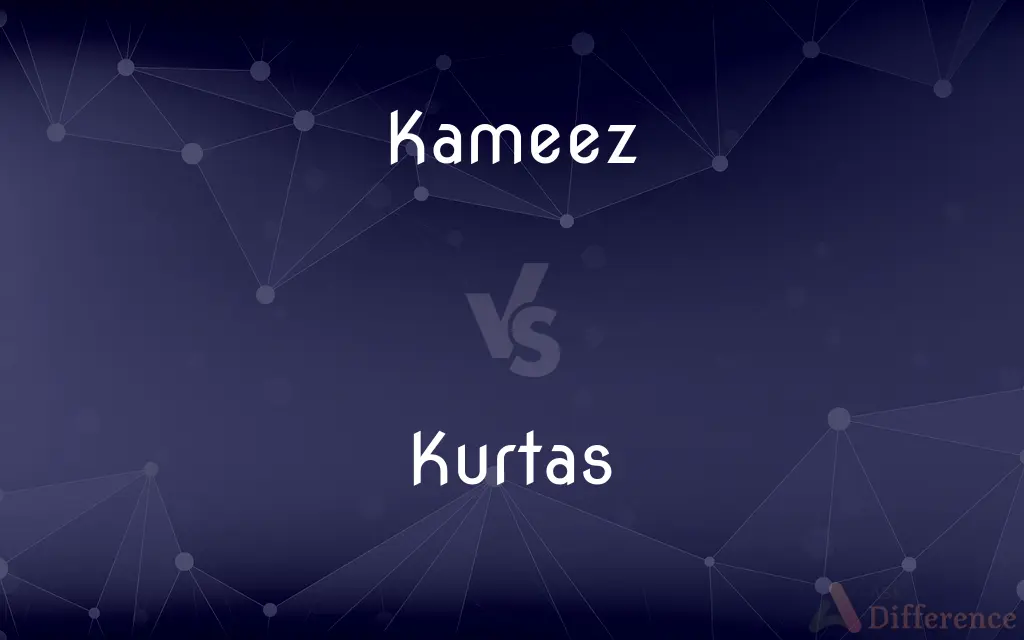Kameez vs. Kurtas — What's the Difference?
By Tayyaba Rehman — Updated on September 19, 2023
A Kameez is a traditional tunic typically paired with a salwar or churidar, while a Kurta is a long shirt, often worn with pajamas or jeans.

Difference Between Kameez and Kurtas
Table of Contents
ADVERTISEMENT
Key Differences
Both Kameez and Kurtas are essential components of South Asian attire. A Kameez, often referred to in the context of a "Salwar Kameez," is a tunic-like shirt typically worn with salwars or churidars. It is a versatile piece of clothing, popular among women, especially in South Asia.
Comparing Kameez and Kurtas, the Kurta is a longer shirt that extends beyond the waist, and it is worn by both men and women. The Kurta often pairs with pajamas, jeans, or even churidars. Its design ranges from simple to highly decorative, and it's a prevalent attire in various South Asian events and everyday wear.
When we talk about Kameez and Kurtas, it's essential to understand the cultural significance behind them. The Kameez has roots in various South Asian cultures, offering a blend of style, comfort, and tradition. The Kurta, on the other hand, transcends cultural boundaries, becoming a sought-after attire in many western countries due to its unique blend of style and comfort.
In terms of appearance and styling, Kameez and Kurtas possess distinct characteristics. While the Kameez is often more form-fitting and pairs with a set of matching trousers and dupatta, the Kurta is more flexible in pairing options, making it a versatile choice for various occasions and preferences.
In conclusion, while both Kameez and Kurtas are traditional South Asian clothing items, they cater to different fashion and cultural preferences. Their unique styles and patterns have not only defined fashion trends in South Asia but have also found prominence in global fashion arenas.
ADVERTISEMENT
Comparison Chart
Traditional Pairing
Paired with salwar or churidar.
Often paired with pajamas or jeans.
Gender Predominance
More popular among women.
Worn by both men and women.
Length
Typically tunic-length.
Usually longer, extending beyond the waist.
Cultural Association
Primarily associated with the "Salwar Kameez."
Wider cultural acceptance in South Asia.
Flexibility in Pairing
Generally worn as a set with matching components.
More versatile in pairing options.
Compare with Definitions
Kameez
Kameez refers to the upper garment in the Salwar Kameez set.
The vibrant color of the Kameez stood out at the party.
Kurtas
A Kurta is a long shirt, often extending beyond the waist.
He wore a white Kurta for the spiritual retreat.
Kameez
A Kameez is a tunic-style shirt commonly worn with a salwar.
Her silk Kameez was adorned with intricate embroidery.
Kurtas
Kurtas can be paired with various types of pants.
The printed Kurta looked great with his blue jeans.
Kameez
Kameez designs range from simple to highly decorative.
She chose a plain Kameez for the casual gathering.
Kurtas
Kurtas are versatile garments worn by both genders.
Her cotton Kurta was perfect for the humid weather.
Kameez
A Kameez typically has a straight cut and can vary in length.
The short Kameez paired well with her churidar.
Kurtas
The design of Kurtas can range from plain to adorned.
His linen Kurta had subtle embroidery on the placket.
Kameez
Kameez can be tailored to be form-fitting or loose.
Her Kameez had a relaxed fit, perfect for the summer heat.
Kurtas
Traditionally, Kurtas are associated with South Asian cultures.
For the festival, he chose a silk Kurta with intricate patterns.
Kameez
A long loose tunic, typically of three-quarter length, usually worn with a salwar.
Kurtas
Plural of kurta
Kameez
Alternative spelling of kamees
Kameez
A long tunic worn by many people from the Indian subcontinent (usually with a salwar or churidars)
Common Curiosities
Are Kameez and Kurtas only South Asian clothing items?
While they originate from South Asia, Kameez and Kurtas have gained popularity worldwide.
Can men wear a Kameez?
While Kameez is more popular among women, men can and do wear styles of Kameez in some cultures.
Is a Kurta formal wear?
Kurtas can be both formal and casual, depending on the material, design, and occasion.
Are Kurtas always long-sleeved?
No, Kurtas come in various sleeve lengths, from sleeveless to full-sleeved.
Is a Kameez suitable for formal events?
Absolutely, depending on the design and material, a Kameez can be very formal.
Can I wear a Kameez without a dupatta?
While traditionally paired with a dupatta, modern styles often forgo it for a more contemporary look.
Are Kurtas suitable for summer?
Yes, Kurtas made of breathable materials like cotton are perfect for summer.
Do westerners wear Kurtas?
Yes, many westerners have embraced the comfort and style of Kurtas.
Can a Kameez be floor-length?
Yes, some styles of Kameez, often called "Anarkali," can be floor-length.
What is the primary difference between a Kameez and a Kurta?
A Kameez is typically a tunic paired with a salwar, while a Kurta is a longer shirt worn with various bottoms.
How do I choose between a Kameez and a Kurta?
It depends on the occasion, your style preference, and the desired pairing.
Do all Kurtas have collars?
No, Kurtas can be collarless or have various collar styles.
How do I care for my Kurta?
Care depends on the material, but most Kurtas can be hand-washed or machine-washed on a gentle cycle.
What fabrics are commonly used for Kameez?
Materials like cotton, silk, georgette, and chiffon are popular for Kameez.
Can I wear a Kurta with jeans?
Yes, a Kurta can be stylishly paired with jeans for a contemporary look.
Share Your Discovery

Previous Comparison
Professional vs. Proficient
Next Comparison
Director vs. EntrepreneurAuthor Spotlight
Written by
Tayyaba RehmanTayyaba Rehman is a distinguished writer, currently serving as a primary contributor to askdifference.com. As a researcher in semantics and etymology, Tayyaba's passion for the complexity of languages and their distinctions has found a perfect home on the platform. Tayyaba delves into the intricacies of language, distinguishing between commonly confused words and phrases, thereby providing clarity for readers worldwide.












































